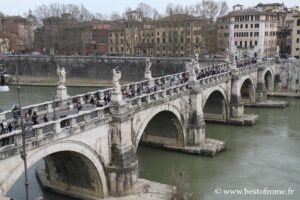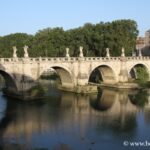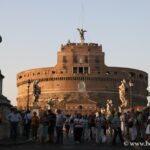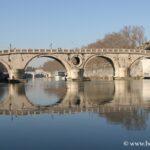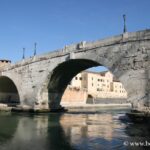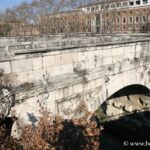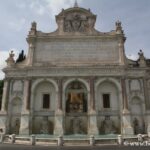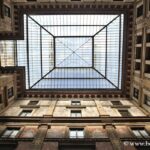Contenu masquer
The bridges, fountains, and galleries of Rome bear witness to its rich past, from Antiquity to the 20th century. This guide explores the Sant’Angelo Bridge with its Bernini statues, the Sisto Bridge connecting Trastevere to the city center, and the ancient bridges of the Tiber Island. It also features the Acqua Paola Fountain on the Janiculum Hill, as well as the Alberto Sordi and Sciarra Galleries, built in the Art Nouveau style. Each section includes descriptions, photos, and useful information to plan your visit to Rome.
Sant’Angelo Bridge: A Baroque Masterpiece on the Tiber
The Sant’Angelo Bridge is built on the foundations of the ancient Pons Aelius, which once linked the Campus Martius to the Mausoleum of Augustus. Today, it leads directly to the Castel Sant’Angelo. Renovated over the centuries, this pedestrian bridge is the most monumental in Rome, famous for its Baroque statues designed by Bernini, depicting the Passion of Christ. These ten sculpted angels, added in the 17th century, make it one of Rome’s most iconic and photogenic bridges.
Sisto Bridge: A Historic Passage to Trastevere
The Sisto Bridge, exclusively pedestrian, is one of Rome’s most charming bridges, with its current form dating to the 15th century, though built on Roman foundations. Connecting the historic center near Piazza Farnese and Via Giulia to the lively Trastevere district at the foot of the Janiculum, it is often enlivened by street musicians or artists. Rebuilt under Pope Sixtus IV, this stone bridge stands out with its elegant central arch, often admired at sunset.
The Bridges of Tiber Island
Tiber Island, at the heart of the Tiber, is accessible via two beautiful pedestrian bridges of Roman origin, offering a unique glimpse into the city’s history.
- Fabricius Bridge: Rome’s Oldest Preserved Bridge – Dating to 62 BC, the Fabricius Bridge is the oldest intact bridge in Rome. Linking the island to the historic center, it retains its original stone arches, a testament to Roman engineering.
- Cestius Bridge: Connection to Trastevere – Built in the 1st century BC, the Cestius Bridge was modified in the Middle Ages. It connects the island to the Trastevere district, offering a view of the river, and dates primarily from the medieval period.
- Ponte Rotto: Remnant of the Ancient Pons Aemilius – The Ponte Rotto, or “Broken Bridge,” is all that remains of the Pons Aemilius, Rome’s first stone bridge (2nd century BC). Its solitary arch in the middle of the Tiber is a poignant symbol of the ancient past.
Acqua Paola Fountain: The Fontanone of the Janiculum
Perched on the Janiculum Hill, the Acqua Paola Fountain, nicknamed “Fontanone,” is a monumental 17th-century work. Designed to celebrate Paul V’s aqueduct, it impresses with its size and panoramic setting over Rome. Located on Via Garibaldi, it is a popular spot for visitors due to its beauty and tranquility.
Alberto Sordi Gallery: Art Nouveau Elegance
Located near Piazza Colonna, the Alberto Sordi Gallery is a shopping arcade inspired by Art Nouveau. This site is a perfect example of early 20th-century elegant architecture and is bustling with shops and a refined atmosphere.
Sciarra Gallery: A Painted Liberty Passage
Just steps from the previous gallery, the Sciarra Gallery is a covered passageway adorned with 19th-century Liberty (Italian Art Nouveau) frescoes. Its colorful paintings celebrating feminine virtues are a hidden artwork in the heart of Rome.
Photo Gallery of Rome’s Bridges, Fountains, and Galleries
- Sant’Angelo Bridge
- Ponte Sant’Angelo
- Ponte Sisto
- Ponte Cestio
- Ponte Fabricio
- Ponte Rotto
- Fontana dell’Acqua Paola
- Galleria Sciarra
- Galleria Alberto Sordi
Sources and Links
- On Rome-Roma: bridges of Rome, fountains of Rome, Sant’Angelo Bridge, Trevi Fountain, Alberto Sordi Gallery, Sciarra Gallery
- Tourism portals Turismo Roma: fountains of Rome, bridges of Rome
Map
Travelers' Map is loading...
If you see this after your page is loaded completely, leafletJS files are missing.
If you see this after your page is loaded completely, leafletJS files are missing.









